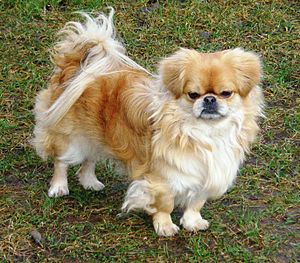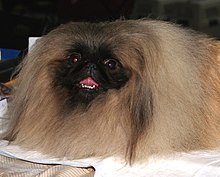Pekingese
| Pekingese | ||
|---|---|---|
|
|
||
| FCI Standard No. 207 | ||
|
||
| Origin : | ||
| Patronage : | ||
| Alternative names: |
Pekingese, Peking palace dog |
|
| Withers height: |
not fixed |
|
| Weight: |
Ideal weight males not over 5 kg, |
|
| List of domestic dogs | ||
The Pekingese (in Germany also Pekingese or Peking Palace Dog ) is a Chinese dog breed recognized by the FCI ( FCI Group 9, Section 8, Standard No. 207 ). The breed standard is being developed by Great Britain.
Origin and history
The Pekingese comes from the Empire of China and was previously reserved exclusively for the imperial family as a palace dog . Like the Lhasa Apso and the Shih Tzu , the Pekingese was formerly called the lion dog .
Porcelain and jade figurines bear witness to a centuries-old tradition of depicting the Pekingese. They experienced their heyday during the Qing Dynasty (1644–1912), from which numerous small sculptures have been preserved. The dogs themselves were bred with great care and especially adored by the last ruler. It was considered unthinkable to give them away or even leave them to one of the hated Europeans. According to legend, Buddha was accompanied by little lion pooches who turned into lions in front of enemies .
It was not until the 19th century that he came to Great Britain . After the conquest of Beijing by British troops in the Second Opium War in 1860, five Pekingese were captured in the imperial palace. British officers took the animals back to Europe. Two couples formed the ancestral parents of the European Pekingese. One was Queen Victoria as a gift. She called him "Looty" (from English loot = spoils of war). The first Pekingese were exhibited in 1864 and recognized by the British Kennel Club in 1898 . The first copies appeared in Germany in 1900.
description
More compact, up to 5.40 kg (many Pekingese are also lighter) heavier companion dog. He wears a lush coat of hair with long, straight, rather hard hair of all colors, often with a dark mask . The breed standard emphasizes the importance of the black pigmentation of the nose, lips and eyelids. The head is relatively large and has a flat profile. The tail is set high and firmly bent over the back to one side. The lush coat requires extensive maintenance.
The 2009 and 2010 standards contain a number of changes. Unlike earlier standards, he demands that the catch must be visible, but relatively short and wide. Instead of a large head, a fairly large head is required and the eyes are now required not to be too large. The standard also re-established that any signs of difficulty breathing or the inability to walk correctly are unacceptable. In addition, certain musculoskeletal abnormalities that were common in the breed are now excluded from the standard. Excessive coat must be severely punished according to the FCI: "The hair should be moderately long, straight with a mane that extends like a scarf around the neck but no further than the shoulder."
health
The Pekingese is a brachycephalic breed. The protruding large eyes are sensitive, the short nose causes shortness of breath . Animal rights activists therefore criticize the guidelines for breeding and a breeding and exhibition practice that increasingly encourages extremely shaped animals. Breeding which foreseeably leads to individuals with damage is prohibited as torture breeding , the Pekingese is one of the breeds listed in a corresponding report . At the Crufts 2012, the title Best of Breed was not awarded because the nominated bitch failed the health test.
Essence
Relatively smart, self-confident, alert and courageous, but also affectionate and cuddly. He doesn't give his affection to everyone. The Pekingese is quite a good watchdog because it doesn't bark excessively, but makes an immediate sound when strangers appear.
Individual evidence
- ^ The New York Times, February 25, 1912
- ^ Presentation of the history of The Pekingese Club UK with the first breed standard
- ↑ Breed standard of the FCI for the Pekingese. Changes compared to the previous standard are printed in bold.
- ^ The Kennel Club: Bulldog and Pekingese fail Crufts vet checks . March 8, 2012. Archived from the original on March 10, 2012. Info: The archive link was automatically inserted and not yet checked. Please check the original and archive link according to the instructions and then remove this notice. Retrieved March 13, 2012.
literature
- Eva-Maria Krämer: The new Kosmos dog handler. Franckh-Kosmos Verlag, ISBN 3-440-07772-1
Web links
- Breed standard No. 207 of the FCI: Pekingese (PDF)
- International Club for Japan Chin, Peking Palace Dogs and King Charles Spaniel (member of VDH )
- 1st German Pekingesen Club from 1987 (member of the VDH)




